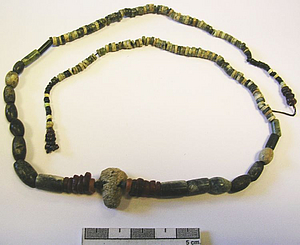Gerzeh
The Gerzeh (el-Gerzhe, Gerza) cemetery, discovered by the British archaeological team in December 1910, is located in northern Upper Egypt, near the Fayum depression, in a shallow valley.
Excavations by Gerald Wainwright from 1910–1911 revealed 288 Predynastic graves, 38 of which had been plundered. Of the undisturbed tombs, 51 contained children, highlighting a high child mortality rate. The tombs varied in size, with oblong rectangular shapes, some up to 1.3m x 0.75m. Notably, many graves contained vases made from galena or malachite, slate palettes, beads, amulets, and animal bones.
One significant find was iron beads, the oldest known iron objects, made from meteorite material. These early iron artifacts suggest an accidental discovery of iron long before its widespread use in Egypt. Red polished vases, distinct for their flattened form and lack of tubular handles, were also common in the Gerzeh graves.
Archaeological activity :
1910–1911: British School of Archaeology in Egypt. Gerald Wainwright led the excavation with W. M. Flinders Petrie as the honorary director.
